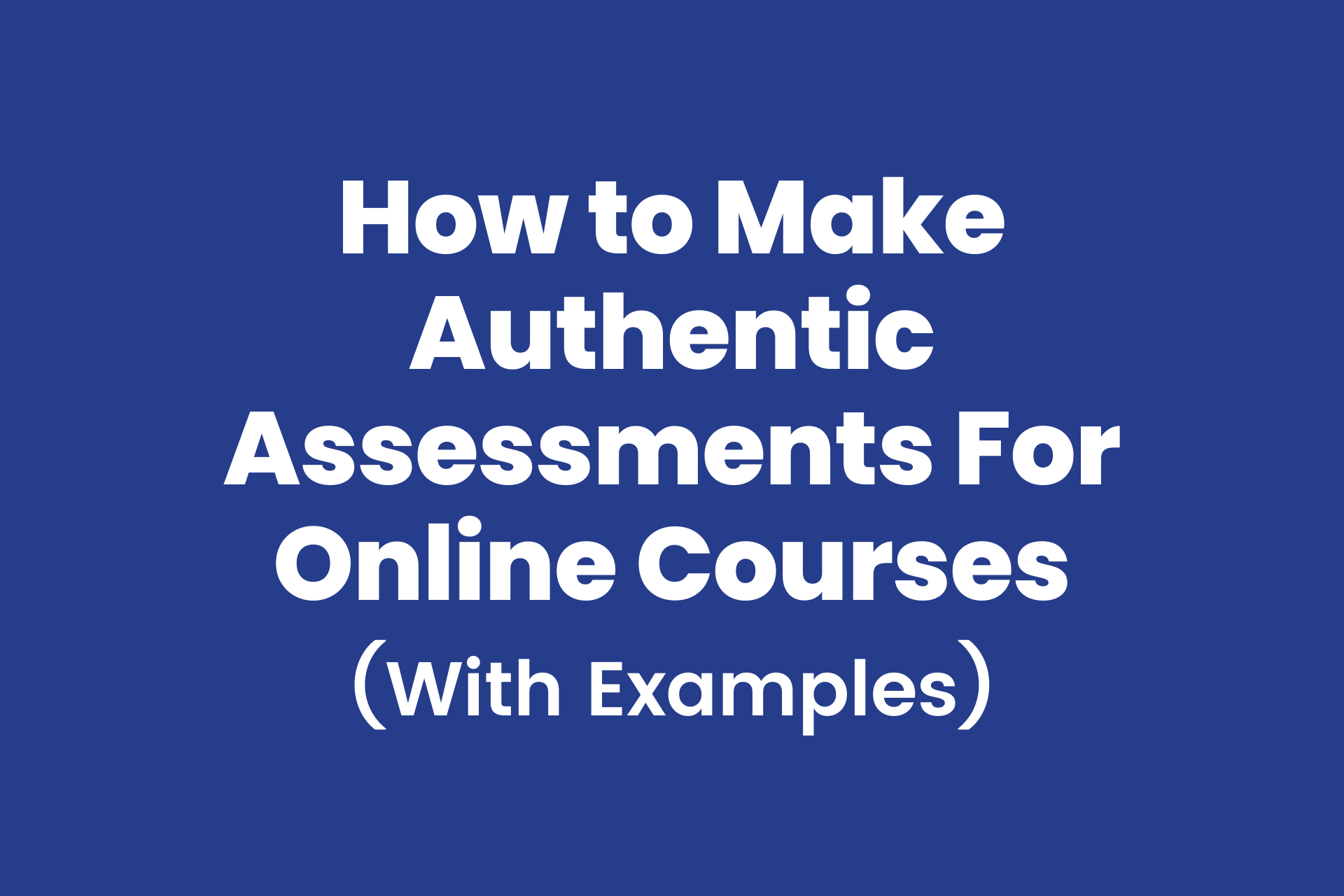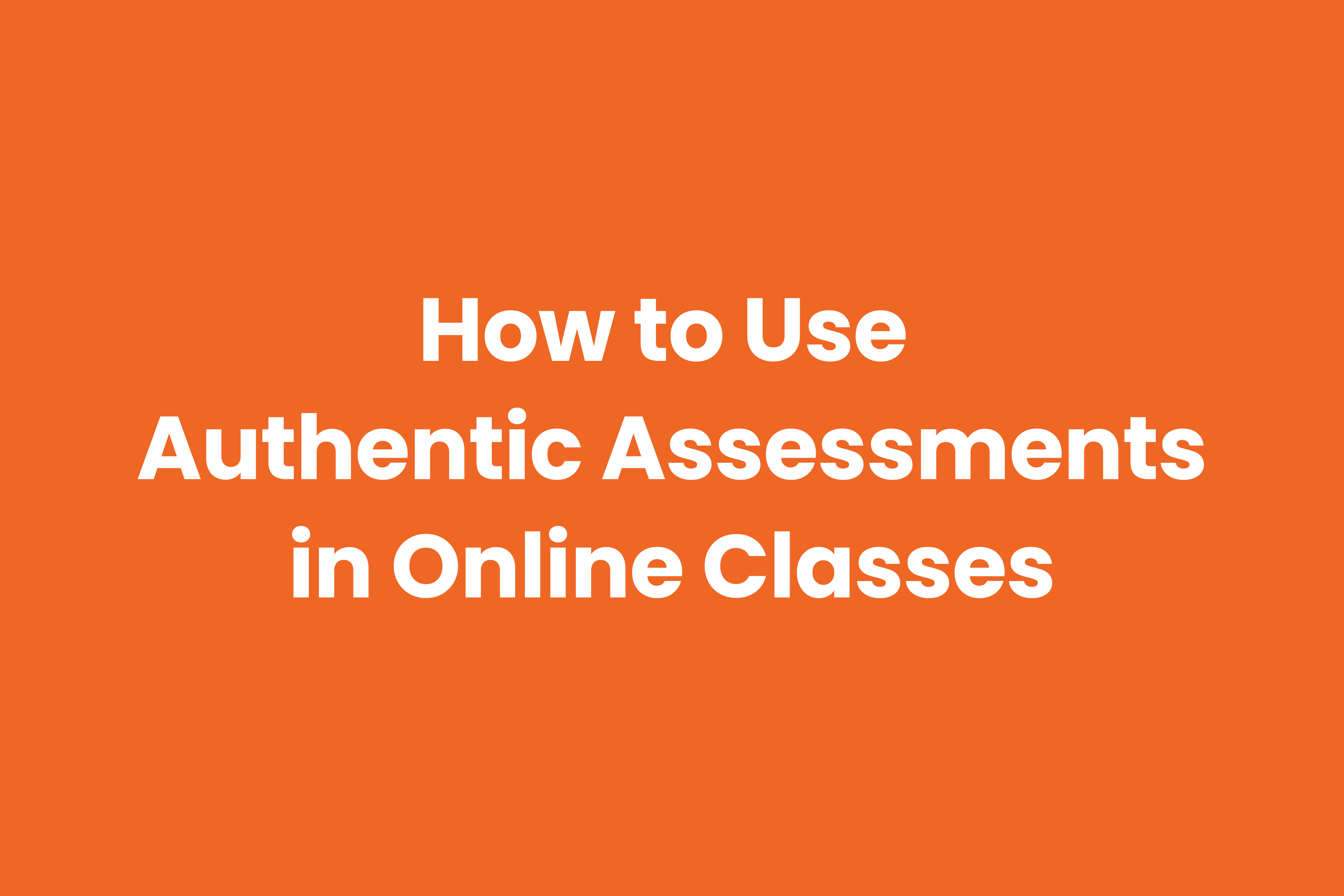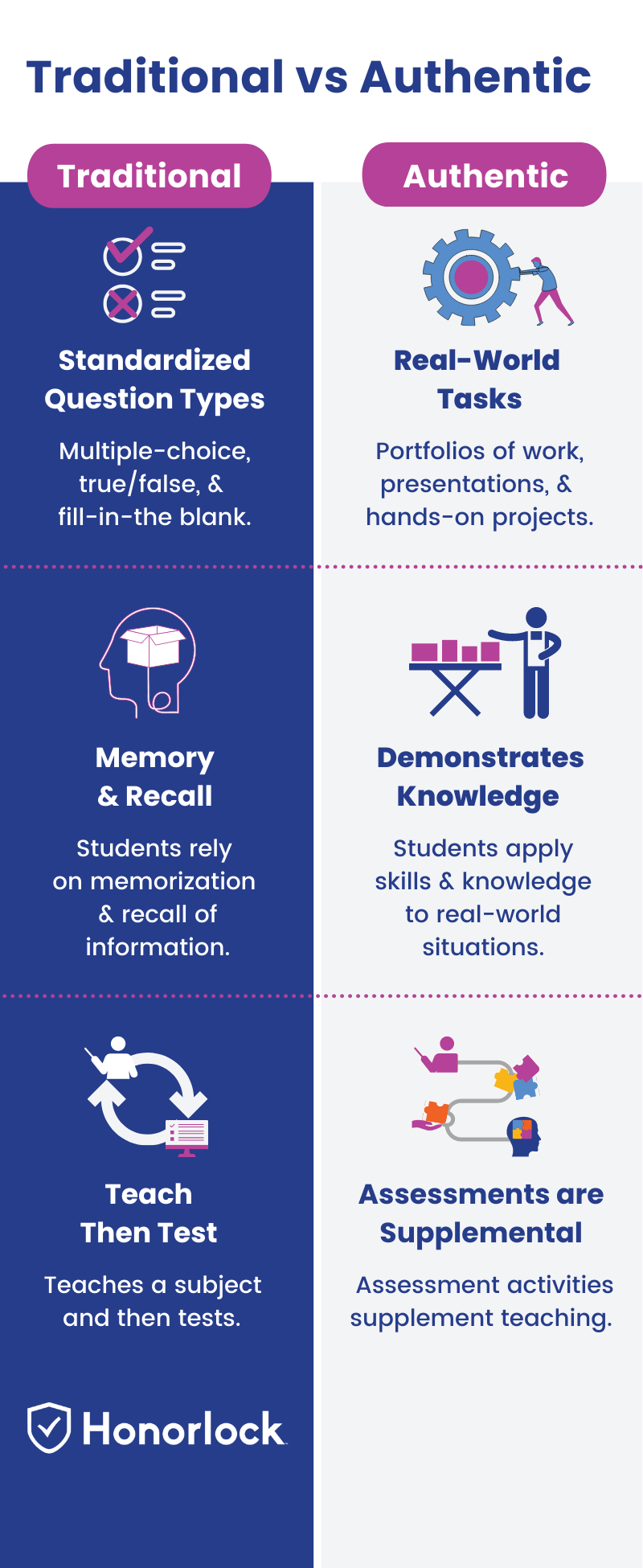Authentic assessments are a great way to make sure that students can apply what they’ve learned in class to real-world situations. While there are many benefits to using authentic assessments, there are also key things to consider before you get started. For more information on what authentic assessments are, see part 1 of our series.
In this article, we’ll show you:
- How to create authentic assessments in five steps
- An example authentic assessment rubric
- How to deter and prevent cheating on authentic assessments
5 Steps to create an authentic assessment
- Write a summary sentence with key assessment objectives
- Break the summary sentence into specific sections
- Write a bulleted list of exactly what students should know for each section
- Write down different authentic assessment activities that allow students to demonstrate their knowledge – don’t forget about web accessibility!
- Choose your assessment activities and create a detailed rubric with descriptions
How to create authentic assessments
Step 1: Write a summary sentence with key assessment objectives
We recommend starting with one or two sentences in order to keep the assessment focused as you continue.
Example:
Students will demonstrate understanding of three process improvement methodologies and the ability to determine which best applies to specific businesses, industries, and situations.
Step 2: Break the summary into individual sections
Example:
Section 1: Demonstrate understanding of three process improvement methodologies
Section 2: Ability to determine which methodology best applies to various situations
Step 3: Write a bulleted list of what students should know for each section
Example:
Section 1: Demonstrate understanding of three process improvement methodologies
- Foundational elements of each methodology: how it works, and when and why it was created
- Common terms and definitions for each methodology
Section 2: The ability to determine which methodology is most appropriate in different situations
- Pros and cons of each methodology
- Why and how each methodology should be used for different businesses, industries, and situation
Step 4: Write down how students can demonstrate their knowledge for each item on the bulleted lists
After you create bulleted lists of what students should know for each section, create a list of how students can demonstrate knowledge for each.
Example:
Section 1: Demonstrate understanding of three process improvement methodologies
- Foundational elements of each methodology: how it works, and when and why it was created
- Written portion: Explain each methodology (1-2 paragraphs)
- Timeline: Create a timeline for each methodology that emphasizes key dates
- Video self-recording: Explain each methodology in 1-2 minutes
- Common terms and definitions for each methodology
- Fill in the blank for terms/definitions
- Written: Write a brief summary of each term that describes when and how they’re used in a real-world effort
Section 2: The ability to determine which methodology is most appropriate in different situations
- Pros and cons of each methodology
- Video self-recording: Verbally explain the pros and cons of each process improvement methodology
- Written: List 3-5 pros and cons of each methodology
- Class discussion: Review a case study, choose a methodology, and then discuss why it should be used compared to a different methodology chosen by another student
- Why and how each methodology should be used for different businesses, industries, and situation
- Presentation: Apply one methodology to a specific case study and explain why and how it was used
- Case study and recommendation: Review real-world case study and provide a recommendation on which methodology should be used to improve efforts.
Keep accessibility in mind as you choose assessment activities
When considering assessment activities, keep web accessibility and compliance standards in mind to help create a fair test environment.
- Is each activity possible for every student regardless of disability or condition?
- e.g., If the activity involves a spoken component, how will students with speech impairments complete it?
- Are all technologies used in the online course compatible with assistive devices?
- Does the LMS, online proctoring platform, and third-party software integrate with assistive technology?
- Are resources needed to complete the activities accessible for each student?
- e.g., Can they all afford a webcam/microphone? If not, do they have access to resources on campus?
Step 5: Choose the activities students will complete to demonstrate knowledge and then create descriptions and clear rubrics for each
After you pick the activities students will complete to demonstrate knowledge, you’ll create detailed descriptions and rubrics for each portion of the assessment. The descriptions and rubrics should be detailed and easy to understand so that students know exactly what’s expected of them.
Note: The example below doesn’t include a description or rubric for students requiring accommodations. However, each student should have assessment activity descriptions and rubrics that provide similar details and formatting. It should also provide information about how to contact the instructor for help.
Example:
For this example, the instructor asks for a self-recording of each student verbally describing the pros and cons of each process improvement methodology.
Example Description: Use your webcam to record a video where you’ll verbally explain the pros and cons of each process improvement methodology. The three process improvement methodologies are Six Sigma, Project Management, and Agile.
For accommodations, please email to discuss alternative options for completing the assessment activities.
For each methodology, you’ll provide:
A 1-minute overview of how each methodology works
A complete overview includes:
- The name of the methodology
- Who created it and when it was created
- The general intent and purpose of the methodology
- e.g., it’s intended to streamline technology implementation and reduce waste
- Two industries that commonly use the methodology
Three advantages and disadvantages for each methodology
- For each advantage/disadvantage, provide clarity on the positive or negative impact and how it affects other areas of the business.
Example:
- Good example: Six Sigma reduces waste by spotting defects in manufacturing processes, which reduces labor costs because it saves time.
- Bad example: Six Sigma saves time and money
Example authentic assessment rubric:

For accommodations, please email to discuss alternative options for completing the assessment activities.
How to deter and prevent cheating during authentic assessments
It can be tricky to protect the academic integrity of authentic assessments because they use many different question types and activities that are outside of standard questions to assess students.
Building on the example in Step 5 where the student is completing a verbal component for the assessment, how would you protect integrity? You could use proctoring software to record the student’s presentation and have them complete a room scan prior to the presentation to make sure that they aren’t reading from their notes.
Click here to see real examples of how use online proctoring for authentic assessments.
But how would you protect academic integrity for other activities in an authentic assessment?
- What if the student is using their cell phone to look up answers to leaked test questions game-based assessment activity?
- What if someone else is completing portions of the exam for the student receiving credit?
Aside from a basic browser lock, which usually isn’t enough to protect exams, what other online proctoring features can help deter and prevent cheating on authentic assessments? Consider an online proctoring solution that combines AI with human proctors to detect cell phones, monitor student behavior, detect voices, identify leaked exam content, verify ID, and more.
Blended online proctoring solutions, such as Honorlock, can help protect your authentic assessments by:
Detecting cell phones
Our AI proctoring software can detect when students attempt to use their cell phones to access test bank content during the exam.
Identifying when your test content has been leaked online
Use Honorlock’s Search & Destroy™ technology to scour the Internet for all of your questions used on the exam in a matter of minutes. If it finds leaked exam questions, instructors are given simple steps to take control of the situation.
Monitoring student behavior and verifying ID
Honorlock’s software uses the students’ webcams to:
- Monitor behavior
- Verify student ID
- Scan the room to make sure that no other people or resources are present
Assessment flexibility and on-demand support
Because authentic assessments can be a bit more complex, students and faculty may need some technical support during the assessment.
With Honorlock, students and faculty can get 24/7/365 US–based support and students can take their authentic assessments whenever they’re ready – no scheduling needed.
Choose a better way to protect academic integrity
Honorlock combines AI software with live human proctors to make online proctoring simple and easy for faculty and students.
During the exam, our AI monitors each student’s exam session and alerts a live proctor to join the student’s session if it detects any potential issues.
This blend of AI and human review delivers a less intimidating and non-invasive proctored testing experience for the student because they aren’t constantly being watched.
Read Part 1: How to use authentic assessment in online courses
Read Part 3: How to proctor online authentic assessments




